#sauropod facts
Explore tagged Tumblr posts
Note
My favorite group of Mesozoic dinosaurs are the sauropods, do you have any fun sauropod info?
The adaptations that allowed sauropods to get big are the same ones that allowed theropods to fly!
Sauropods *didn't* use gizzard stones!
Sauropods were able to maintain a consistent internal body temp through the force of their giant bodies alone!
The closer a Sauropod gets to the Colossosaurs (the really big titanosaurs), the fewer fingers it has! Column feet!
Sauropods probably used their long necks for display and possibly for intraspecific combat!
Most sauropods were so big cryptic coloration would have been useless and they were too big to be hunted anyway, so they were probably very colorful!
While everyone knows Apatosaurus/Brontosaurus, they are actually part of one of the least diverse and common sauropod groups!
Sauropods were MORE successful in the Cretaceous, not less!
Titanosaur phylogeny is a mess from which we will never escape!
Sauropods breathed like birds!
Sauropods had bones like birds!
Some sauropods had beaks!
Sauropod teeth tell you a lot about how they ate - some had peg like teeth, others more spade like, and they cropped off plants in different ways!
We are still arguing about how Sauropods may have held their necks!
The first Sauropods appeared in the Triassic of Southeast Asia!
Some sauropods used lava fields and other places of geothermal activity to brood their nests!
249 notes
·
View notes
Text
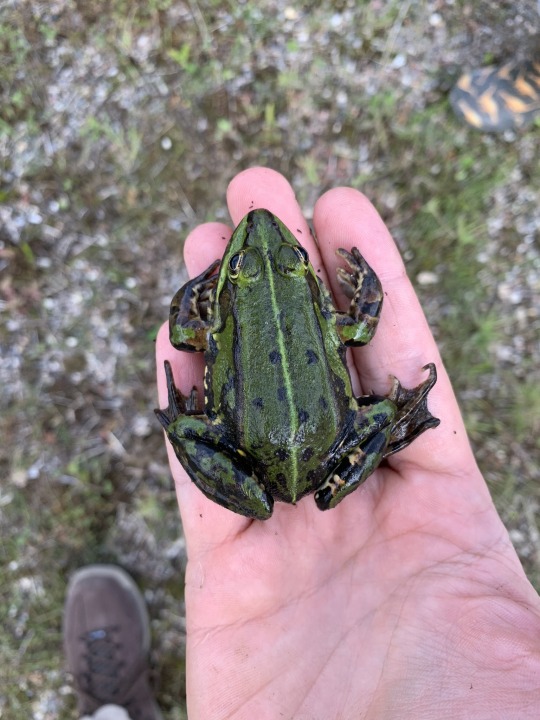
Behold, the European platonic ideal of a frog.
#frog#animals#wildlife#nature#amphibian#the fact that the literal bog-standard frog in Europe is commonly known as the 'edible frog' is also quite telling#I say European platonic ideal because this is NOT what the ideal frog looks like if you were to average all modern frogs out#for one that frog would almost certainly be brown#but also it would be MUCH smaller#and have probably much less webbed feet#Pelophylax#Pelophylax kl. esculentus#why yes my son does have sauropod gumboots thanks for asking
2K notes
·
View notes
Text

Get a leg up on the weekend with these colossal limbs! Snapped circa 1899, this archival photo from the Museum’s digital collections depicts a Museum preparator standing beside the fossilized limbs of dinosaurs discovered in Wyoming. The larger bones belong to sauropods, while the smaller bones belong to a theropod—likely Allosaurus.
Photo: Image no. 46523 / © AMNH Library
#science#amnh#museum#fossil#nature#natural history#dinosaur#animals#paleontology#fact of the day#did you know#sauropod#theropod#archival images#natural history museum#museum of natural history
1K notes
·
View notes
Text
Monday Musings: Who hunted Sauropods?
With the immense size of most sauropods it is hard to imagine what might have been brave enough (or stupid enough) to take one on. It seems unlikely but theropod tooth marks have been found on sauropod bones so we know they were being eaten at the very least.
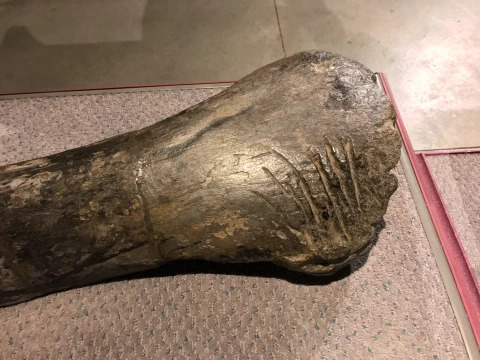
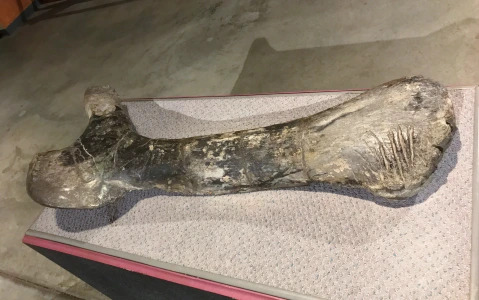
Mmm, Apatosaurus ischium.
Allosaurus is probably the most well-known of the sauropod predators. Often found alongside sauropod remains, it is highly likely that it hunted juveniles or sick adults in packs. One hypothesis for its hunting strategy is that it would use its head somewhat like an axe.

It had a relatively weak bite force but incredibly strong neck muscles. Its skull could withstand forces almost 15x that of its bite. They were also fast sprinters so they could ambush their prey. They would run up, use their massive, recurved claws on their hands as hooks to grapple prey much like raptors (meaning birds of prey, actual raptors) and then use their jaws to rake flesh off the sauropod causing it to bleed out. This allowed Allosaurus to follow behind at a safe distance while its prey bled to death.


Allosaurus vs Barosaurus
It is likely that cousins of Allosaurus such as Carcharodontosaurus, Giganotosaurus, and Mapusaurus also hunted sauropods in packs. All of these carnosaurs lived in sauropod heavy environments and had similar body plans that would allow them to hunt in similar fashions.
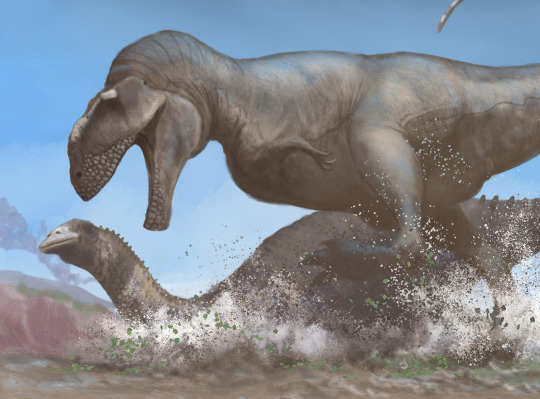
Carcharodontosaurus vs Rebbachisaurus by Mark Witton
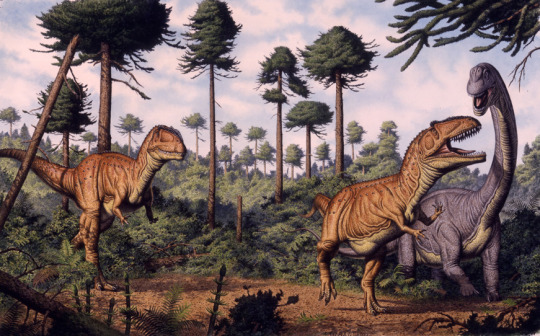
Giganotosaurus and Sauropod by Bob Walters and Tess Kissinger

Mapusaurus vs sauropods
It has also been suggested that abelisaurids like Majungasaurus were specialized for hunting sauropods. With short, broad snouts they might have hunted like modern felids: bite and hold on.

Majungasaurus tooth marks have been found on Rapetosaurus bones so we know they were eating sauropods at the very least.
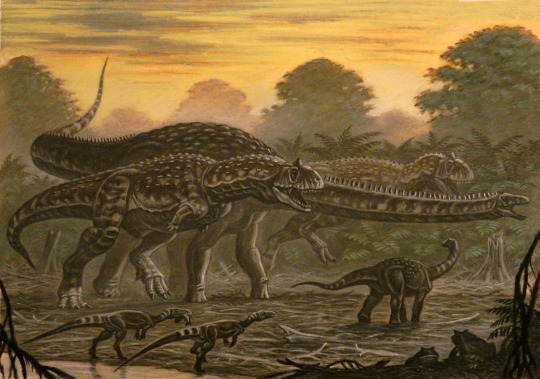
#paleontology#fossils#dinosaur#fun facts#allosaurus#sauropod#carcharodontosaurus#giganotosaurus#theropod#bite force#predator#prehistoric
42 notes
·
View notes
Text
This year has gone by fast! There are only 44 more days left of 2023 so to celebrate I’m gonna make a post about five extinct animals that were described this year!
1. Bos primigenius thrinacius n. ssp.
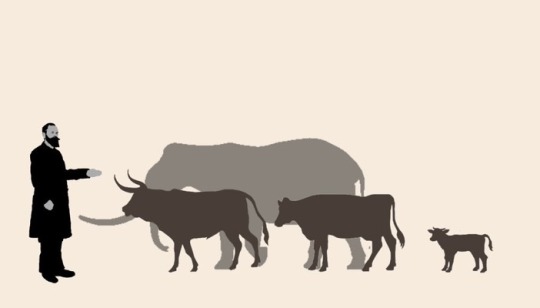
(Bos primigenius thrinacius n. ssp. Size estimate of a bull, cow, and calf compared to a human and an adult Palaeoloxodon falconeri. Art by Joschua Knüppe)
This new sub species of Aurochs lived on the Greek island of Kythera during the Late Pleistocene. The sub species was probably present on Kythera while it was still part of the mainland, but became trapped when it was separated sometime during the Middle to Late Pleistocene and their small size was a result of insular dwarfism. Insular dwarfism is a common phenomenon in evolution where a population of large animals becomes trapped on an island and slowly evolve to become smaller over time to better adapt to the reduced space and resources. The opposite, insular gigantism, where an island-bound population of small animals grows larger than their mainland counterparts also occurs regularly. During the Pleistocene, the various islands of Greece were full of giant swans and miniature elephants but now we know they had tiny cattle roaming about as well.
2. Garumbatitan morellensis
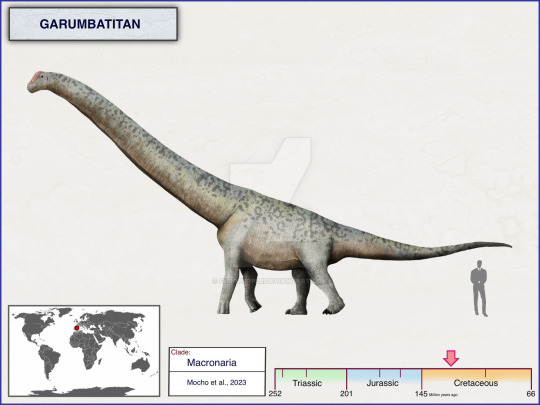
(Size comparison between Garumbatitan morellensis and a human. Art by cisiopurple on Deviantart)
Meaning “Garumba Giant”, Garumbatitan morellensis was a species of sauropod dinosaur that lived during the Cretaceous period in what is now Spain. Its remains were first discovered in 1998 at the Arcillas de Morella Formation near the city of Morella, however, they would not be excavated until an expedition in 2005. More material would later be discovered in a 2008 expedition and a paper would be published on the findings in 2016, but it wasn’t until this year that the species was officially named and described. Its genus named is a mix of the name for the tallest mountain in the region it was discovered in, Mola de la Garumba, and the Greek word “Titan”.
3. Nihohae matakoi
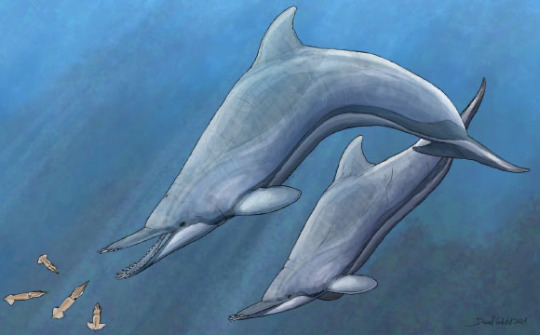
(A pair of Nihohae matakoi hunting some squid. Art by Daniel Verhelst)
Nihohae matakoi was a species of dolphin that belonged to the now extinct Waipatiid family and lived during the Oligocene in the waters surrounding what is now New Zealand. It possessed a bizarre set of tusk-like teeth that protruded from its beak. It is thought that this dolphin used it’s strange teeth much like a sawfish to stun their prey before consuming them. The holotype specimen was discovered all the way back in 1998 in Awamoko Valley on New Zealand’s South Island. The specimen consisted of a nearly complete skull, a single atlas and axis, eight vertebrae, and seven ribs. However, Nihohae matakoi would not be officially described until 2023. Its genus name combines the Māori words “Niho”, meaning “teeth”, and “Hae”, meaning “slashing”. The species name is also derived from Māori and comes from the words “Mata”, meaning “face” or “point”, and “Koi”, meaning “sharp”.
4. Perucetus colossus
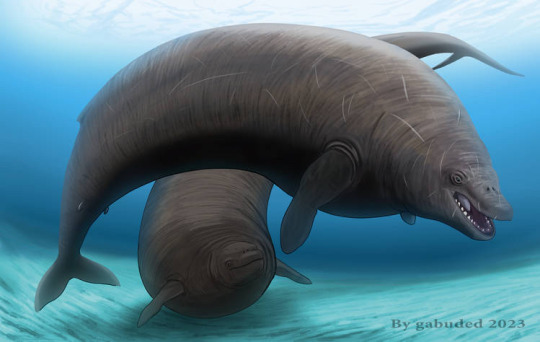
(A pair of Perucetus swim together in the shallows. Art by Gabuded on Deviantart)
Another cetacean, Perucetus colossus was a species of early whale that lived during the Bartonian age of the Middle Eocene and was found in Peru (obviously). The remains we have or Perucetus are pretty fragmentary, but it has an estimated length of around 55.8-65.9 ft and was probably just as, if not heavier, than the modern Blue Whale. Due to the density of its bones and its absolute chonkiness, Perucetus likely was not a fast swimmer and likely lived in shallow waters and fed on crustaceans and mollusks. However, this is just speculation as very little about its ecology is known.
5. Vectipelta barretti

(A pair of Vectipelta barretti graze near a stream. Art by Stuart Pond)
Vectipelta barretti was an ankylosaurian dinosaur that lived during the Early Cretaceous in what is now England. It was discovered in the Wessex Formation and it’s genus name means “Isle of Wight shield”. The holotype specimen of Vectipelta was originally discovered in November of 1993, however, at the time it was believed that the specimen belonged to the genus Polacanthus. In May of 2021 it was discovered that the specimen was in fact a new genus and in June of 2023 it was officially named and described. Funnily enough, fossil evidence suggests that Vectipelta might be millions of years older than Polacanthus, the genus it was originally thought to be a member of.
I hope you all enjoyed reading about these recently described prehistoric species! I LOVE dinosaurs and other extinct animals and can’t wait to see what new discoveries 2024 has to offer!
#dinosaur love#animals#new discoveries#infodump#science#dinosaur#peru#new zealand#isle of wight#Kythera#new species#animal news#animal facts#dinosaur facts#paleontology#spain#2023#ankylosauria#sauropod#aurochs#cetacean#perucetus
25 notes
·
View notes
Text
Dinofact #113
Small in size for a sauropod, Brachytrachelopan had an exceptionally short neck - 40% shorter than any other dicraeosaurid and the shortest of any known sauropod. Brachytrachelopan measured only 10–11 metres (33–36 ft) in length and weighed only 5 metric tons (5.5 short tons).
Source: Wikipedia
#dinosaur#dinosaurs#paleontology#brachytrachelopan#sauropod#sauropods#sauropoda#dicraeosaurid#dicraeosaurids#dicraeosauridae#records#fun facts#trivia#dinosaur trivia#dinosaur fun facts#29th#december#2022#december 29th#december 2022#december 29th 2022
11 notes
·
View notes
Text
I never realized how anatomically similar the legs of an elephant and horse were until I just now looked up "Elephant laying down" for a reference image to draw a sauropod lying down for pokemon anatomy practices.
#I ALSO found out that sauropods walking motions are more similar to that of a hippo#so there's you're fun fact of the day#this is how adhd does it#I'm keeping the elephant leg reference#DingusPost
2 notes
·
View notes
Text
Something a bit weird about the Proto Beasts and Neo Swords - so I’ve seen fan concepts of the Proto Beasts from before Bolt was announced where the three of them were all theropods like Wake. Nothing against those fan concepts but I feel like if they took that path the three of them would have been too samey. On the other hand, the Neo Swords who are infinitely more samey than the Proto Beasts would have been if they were all theropods (at least partly because the Swords of Justice are a lot more similar to each other than the Legendary Beasts are to each other I mean I guess there’s also the fact that the Past Paradox Pokémon don’t know how to stick to a theme while the Future Paradox Pokémon all perfectly understood the assignment) feel like the way they’re all similar to each other makes them the perfect trio
#proto beasts#neo swords#pokémon#I don’t mind how the Future Paradox Pokémon are all samey btw#they realised they had a theme and they stuck to it#the Past Paradox Pokémon didn’t even realise their main theme until Wake was shadowdropped#and even then Fire and Bolt struggled with it#I can’t blame them to be fair I’ve been too harsh on them#it probably takes real skill to turn mammals into ceratopsians and sauropods while avoiding the lion/bear/etc and giraffe allegations#but like with Crown being based on Cobalion (it wasn’t obvious to me okay)#they are pretty clear you just have to know that’s what you’re looking for#you can say the theme was “Pokémon but prehistoric” not “Pokémon but dinosaur” but the tails suggest otherwise#like mammoths didn’t have tails like those#plus Flutter Mane is explicitly stated to be a pterosaur because trust me no one would’ve got that if it wasn’t pointed out#the only thing it has in common with pterosaurs is the fact that it flies and even then I’d say it floats not flies
1 note
·
View note
Text


Koleken harassing a Titanomachya.
The small sauropod however has an unusual defense mechanism. From glands along its neck it sprays a foul smelling liquid onto the abelisaur.
This idea is completely speculative and would probably never preserve. It's based on the one hand on golden tailed geckos and on the other on the fact that we have in South America a bunch of very small titanosaurs living in ecosystems with enormous theropods.
#paleoart#sciart#paleostream#palaeoblr#cretaceous#dinosaurs#sauropod#koleken#titanomachya#titanosaur
835 notes
·
View notes
Note
Tell me a shroom fact please
a recently-found amber fossil (dating to ~100 million years ago) suggests that dinosaurs ingested psychotropic fungi !!

in this fossil, we see some of the earliest recorded evidence of grass. atop the grass? a fungal parasite. in comparison with our fungi today, this fungus is most similar to ergot - fungi that grow on rye & produce alkaloids. ergot has been used as a medicine, a poison & a hallucinogen by humans for thousand of years.
"there’s no doubt in my mind that it would have been eaten by sauropod dinosaurs, although we can’t know what exact effect it had on them." - george poinar jr, of the oregon state university's college of science.
the small chance that dinosaurs tripped on psychedelics keeps me going, tbh.
#• finn's freaky fungi fact ^^ •#• askbox replies: •#(ask : warmilkbread)#||#fun fact#dinosaurs#amber#paleontology#fossils#grass#dinos#science#biology#history#fact#mushrooms#fungus#mycology#mushroom#earth#nature#fungi
912 notes
·
View notes
Text
Dino figure of the day: Two-Headed Sauropod-Esque Beast (Toymendous, Walmart)
I have no idea why this guy is like this, but he may be inspired by this similar design by Imperial Toys (1980s):

A fascinating beast indeed.
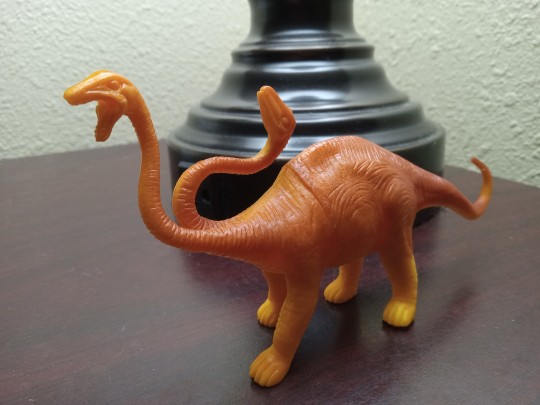
For some reason, exactly one dinosaur design out of a batch of cheap plastic dinosaur toys at Walmart inexplicably has TWO HEADS.
None of the others have any unusual features. All very standard cheap plastic dinosaur type designs. There's no winged T-Rex, no triceratops with eight legs, no ankylosaurus with a cat-o'-nine-tails style multiple branched club-tail... nothing weird.
Except for this two-headed longneck.
#dino figure of the day#vintage#sauropod#dragons#arguably#toymendous#imperial#i mean tbf to a little kid two heads are definitely cooler than one#deeply inaccurate#fun fact the walmart dinos line has knockoffs of the papo dimetrodon and rebor yutryannus
60 notes
·
View notes
Text
It's worth doing a full analysis on how the Jurassic Park franchise makes the "bad man-eating carnivore, nice and friendly herbivore" dichotomy so prevalent it's almost a staple of its writing now. In Jurassic World, the pteranodons get released and they attack humans for no other reason that, well, this is a monster movie and they have to. In Camp Cretaceous, there's a carnotaurus that stalks and wants to kill the kids for no other reason than well, this is a monster series and they have to have a monster, but they approach and make friends with a Pachyrhinosaurus because it's an herbivore and herbivores are nice. Now, I can't say for sure what was the exact behavior of a Pachyrhinosaurus, but based on our current large horned herbivores, I have a feeling approaching one would be as a good idea as a stranger approaching a bull or a rhinoceros.
These are the examples I can recall now, that's why I said it would be great to do a full analysis, but it all comes down to the fact that in the writing herbivore = good and carnivore = bad. In real life, and thus we can assume that for dinosaurs, large herbivores are extremely territorial and aggressive, always on the look out for any potential threat. A human just happens to be around the size of a random dromeosaur and bipedal too, if a dinosaur saw or heard a bunch of humans approaching it, it would be in alarm mode instantly. Big sauropods might not care out of sheer size, but I don't think it would be safe to approach a 30 meter long animal either. Meanwhile, carnivores would not be safer, either, but most apex predators tend to spend the time between hunt resting and trying to conserve energy, lazying around.
I mean, I'm being generic here since there are lots of kinds of animal behavior but it's never "good nice herbivores". In fact, the nice herbivores we know are because of domestication, because wild goats/sheep and horses are incredibly aggressive, and I'm still not sure how we domesticated aurochs or fucking boars.
But that's because Jurassic Park isn't as much as interested in showing an ecosystem or actual behavior, but rather, the dinosaurs are characters too in a movie, and you have good and bad characters. Which is fine, I mean, it's not a documentary, is it? But many people do treat it as such, in the sense of what they see there is what the popular conception of dinosaurs are, and even the conception of how animals and ecosystems 'work' in the first place. I'm not blaming Jurassic Park for seeing all those people commenting "why didn't you rescue it???" in videos of a wild animal predating another, but I do think it's a kind of thinking (moralizing animals) that comes from that viewpoint.
94 notes
·
View notes
Text
Did you know that the Museum is home to largest collection of dinosaur fossils in the world?
#science#amnh#museum#fossil#dinosaur#natural history#nature#animals#paleontology#video#sauropod#tyrannosaurus rex#fact of the day#did you know
2K notes
·
View notes
Text
Fossil Friday: Mamenchisaurus

A fairly well known sauropod, Mamenchisaurus was discovered in 1952 in a highway construction site in China. It was named Mamenchisaurus constructus by C.C. Young. This holotype specimen consisted of five dorsal vertebrae, 30 caudal vertebrae, rib fragments, dorsal neural spines, and chevrons. Fourteen cervicals were preserved but none were complete. There were also chunks of a femur, a complete tibia, fibula, astralagus, metatarsals, phalanges, and claws.
A second species, M. houchuanensis, was described in 1972. Locals had first discovered the animal during the Chinese Revolution but ultimately they were abandoned and excavation didn't occur until 1957. It became the holotype of this species and it had an almost complete and articulated vertebral column including 19 elongated cervicals, 12 dorsals, four sacral, and 35 caudals.
A third species, M. sinocanadorum was found in 1987 in a different formation and basin from the other two. This specimen consisted of a left mandible, a right dentary, a vomer, a right pterygoid, a possible ectopterygoid, a right quadrate, parts of the second through fourth cervicals, and an intact left cervical rib. This was the first time a skull for the genus was found.
A fourth species M. youngi was described in 1996. This was a very complete holotype preserving all vertebrae from the head down to the 8th tail vertebra, the pectoral girdle, pelvic girdle, and material from all four limbs. A rare feat for a sauropod.
Finally, a fifth species M. jingyanensis, was described in 1998. The type specimen includes a partial scapula, a complete coracoid, forelimb material, a complete ischium, a relatively complete skull, and a hyoid bone.

The most exceptional part of the this genus lies in its neck of which almost half their total body length comes from. They have between 18 and 19 cervical vertebrae (for reference, humans only have 7 and a Diplodocus only had 15.) This makes it the animal with the longest neck. In fact, even though elasmosaurs (very long-necked plesiosaurs) had up to 76 cervicals in some cases, those cervicals were short and overall body length was only 39ft (11.88m) while Mamenchisaurus's neck alone was 31ft (9.3m) long.
Well, it has been a blast discussing sauropods this month. Next month, I will be out in the field so I will not be posting to this blog. However, if you want to keep up with me I will be doing livestreams on TikTok to show what paleontologists do out in the field. It's a treat that most people never get to experience so I do hope you come to see. I will try to film between 8 and 9am MST everyday so keep an eye out. Here is the link to my profile so you can check it out!
#paleontology#fossils#dinosaur#fun facts#longest neck#mamenchisaurus#sauropod#late jurassic#mesozoic
14 notes
·
View notes
Text
sometimes i wake up and i remember that I LOVE DINOSAURS !!!!!! RAAAAGHHHH !!!!!!! anyways anyone else ever think about the kem kem beds. because i do.
kem kem beds save me. save me kem kem beds. the disproportionate split between large herbivores and megatheropods enamors me. what do you mean theres just only sauropods and no other large herbivores. what do you mean theres like 20 different large theropod species running around at the same time. why are there fish that damn BIG. what even are noasaurids. also spinosaurus is here.
kem kem group so fine kem kem group divine. my roman empire is thinking about how the ecosystem of the kem kem beds was so incredibly diverse that it allowed for all of these different VERY LARGE carnivores to coexist because they all occupied different niches in the environment. which just totally crumbles the stereotype of Big Theropod Deathmatch because uh yeah, sorry jw bros, we have proof of some of the largest theropods in history all living in the same place at the same time!!! successfully!!! animals do not just go around beefing and fighting one another 24/7, especially carnivores. carcharodontosaurus and spinosaurus are not fistfighting everytime they see one another. spinosaurus is busy sleeping like a log on the riverbank and carchar is just coming by to get a drink. carchar accidentally steps on spino's tail and the spino snaps at it but misses completely because its half asleep and stupid. carchar walks away. they are just animals !!! and every ecosystem is incredibly complex and i love that even though we only have fossils and rocks to go off of this fact is SO evident across the globe but kem kem beds is so special to me. in my heart. anyways very rough sketch to go along with this train of thought.
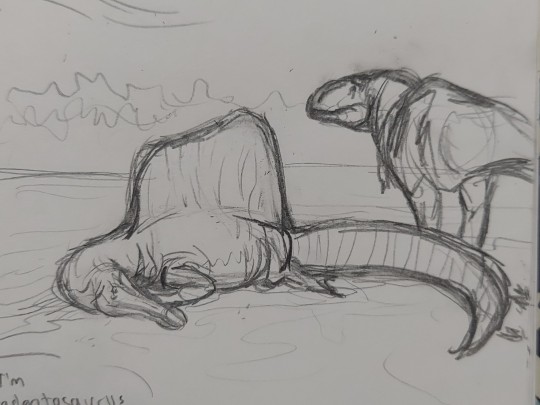
i miss you kem kem beds. sighs dreamily
#dinosaur#dinosaurs#paleontology#paleoblr#fossils#spinosaurus#carcharodontosaurus#sigh#i miss u kem kem group .... every day#dinosaurs being treated like any other animal ... something i savor more than anything#rodtalks
101 notes
·
View notes
Text
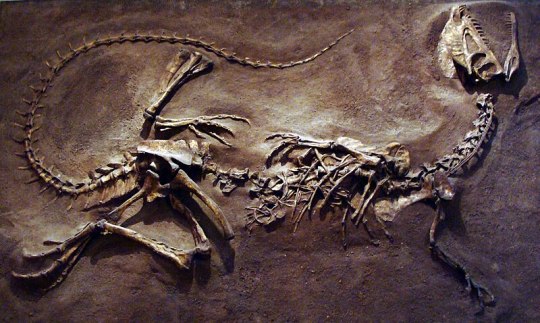
Name: Dilophosaurus wetherilli
Debut: Real Life, Circa The Early Jurassic (roughly 280 million years ago)
Hi I'm gonna talk about my favorite dinosaur now and you're gonna like it! Or maybe you won't, I don't know you! But y'know what I do know? Dilophosaurus!!! It's my best friend. They named it after the fact that it's got two (di) crests (lopho) on its head and also it's a reptile (saurus). A big reptile at that! In fact, it was the largest known animal of its time to walk the land in North America, and was almost certainly the apex predator of its environment, the Kayenta Formation (located across several of what are now the South-Western United States).

As you can see, this size chart demonstrates that the largest specimen discovered was about 7 meters (23 feet) long; no Tyrannosaurus rex, mind you, but still far larger than... some popular depictions might lead you to believe.
Also contrary to what some popular depictions might lead you to believe, Dilophosaurus would not have required the use of various biological mechanisms such as, for instance, retractable neck frills or venom-spitting to take down its prey; mechanisms which, mind you, are exclusively seen in animals as methods of self-defense, and would therefore only serve to scare away potential prey items.
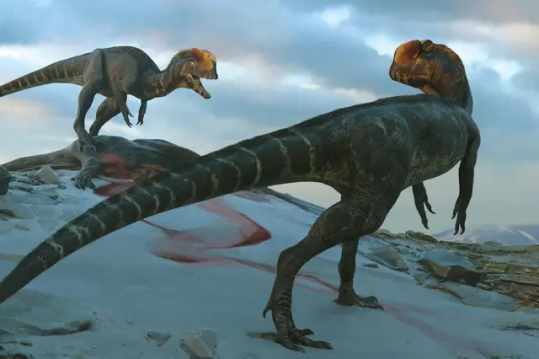
Speaking of prey items, this stunning piece by Chase Stone depicts a pair of Dilophosaurus as having just brought down a prosauropod (a name for early sauropod relatives). Dilophosaurus did in fact live alongside at least one prosauropod, Sarahsaurus, the Holotype specimen of which bears tooth marks very likely left by a certain two-crested culprit! On that note I want to address another prevalent misconception in regards to life reconstructions of this animal...
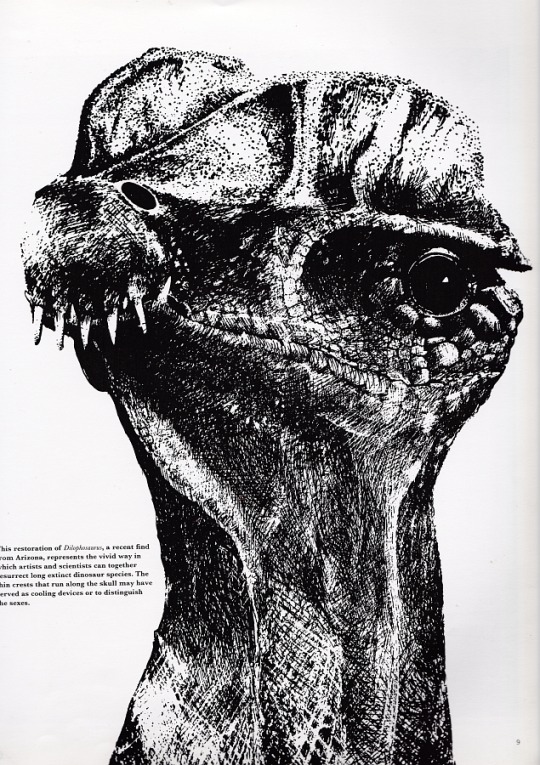
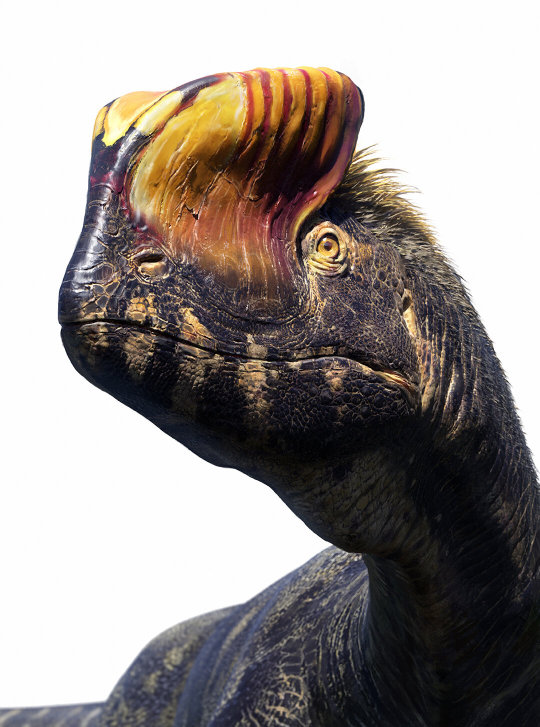
On the left we have a (frankly hilariously sock-puppet-like) restoration by a sadly unknown artist, and on the right is another absolutely breathtaking rendering by Chase Stone. As you can pretty clearly see, the way the crests (among other things) are restored is very different between the two! For a long time, the crests were restored as seen on the left: very thin, and with a little protrusion jutting out of the back. This is due to something called shrink-wrapping, a trend in paleoart exemplified by the omission of tissues such as muscle or fat when reconstructing the animal, leading to much of the skeleton being visible through the skin, particularly in the case of the skull.
Stone's restoration, on the other hand, wraps the skull in a much more naturalistic-looking amount of soft tissue, and completely envelops both crests in a keratinous structure, much like the casque of a cassowary or a hornbill (in fact I believe the coloration is actually referenced specifically from a knobbed hornbill's beak).
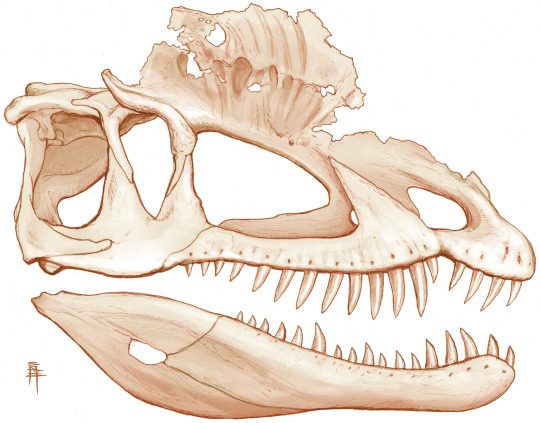
This is due to the fact that the crests were likely a kind of bony core which would have supported a larger keratinous structure as is to be expected of... sigh... horny structures such as this. Stop smiling. Don't you know there's no fun allowed when you're learning about things? That's what school taught me, anyway. Ahem. As I was saying, the original shape of the crest was extrapolated from incomplete remains, which you can see a restored illustration of above.
Also worth noting is the inclusion of a thin, fluffy covering of feathers along the head, neck, and back of Stone's restoration. This is entirely plausible, as the current consensus is that dinosaurs and their close relatives, pterosaurs, were descended from a fluffy common ancestor due to the fluffy-feathery coverings seen in both groups being found to be basically the same stuff!

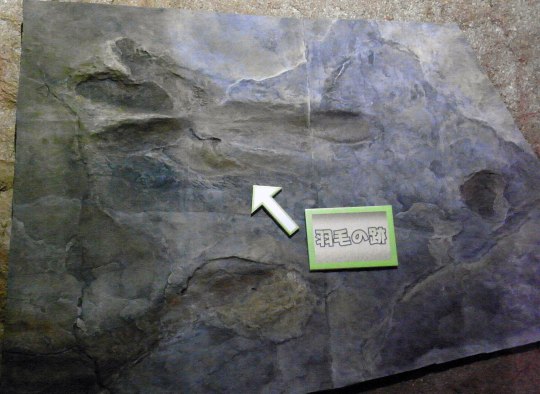
I could go on about so many things, like how tremendously fucked up and addled with tumors and infections the Holotype specimen was, or how we have a trace fossil which seems to preserve a Dilophosaurus sitting down in the mud like a big dumb bird, complete with an impression of its butt, but I trust that if these things pique your interest enough, you'll seek them out on your own time. Just remember not to have fun, because as we all know, fun is the one thing learning should never be.
61 notes
·
View notes